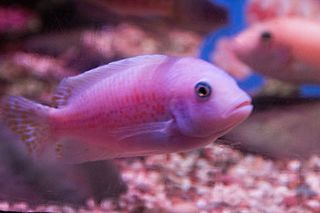
Cichlids are fish from the family Cichlidae in the order Cichliformes. Traditionally Cichlids were classed in a suborder, the Labroidei, along with the wrasses (Labridae), in the order Perciformes, but molecular studies have contradicted this grouping. On the basis of fossil evidence, it first appeared in Tanzania during the Eocene epoch, about 46–45 million years ago. The closest living relative of cichlids is probably the convict blenny, and both families are classified in the 5th edition of Fishes of the World as the two families in the Cichliformes, part of the subseries Ovalentaria. This family is large, diverse, and widely dispersed. At least 1,650 species have been scientifically described, making it one of the largest vertebrate families. New species are discovered annually, and many species remain undescribed. The actual number of species is therefore unknown, with estimates varying between 2,000 and 3,000.

The oscar is a species of fish from the cichlid family known under a variety of common names, including tiger oscar, velvet cichlid, and marble cichlid. In tropical South America, where the species naturally resides, A. ocellatus specimens are often found for sale as a food fish in the local markets. The fish has been introduced to other areas, including India, China, Australia, and the United States. It is considered a popular aquarium fish in Europe and the U.S.
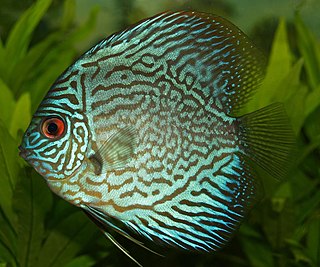
Symphysodon is a genus of cichlids native to the Amazon river basin in South America. Due to their distinctive shape, calm behavior, many bright colors and patterns, and dedicated parenting techniques, discus are popular as freshwater aquarium fish, and their aquaculture in several countries in Asia is a major industry. They are sometimes referred to as pompadour fish. The discus fish has attracted a cult following of collectors and has created a multimillion dollar international industry complete with shows, competitions, and reputable online breeders.

Symphysodon discus, the red discus or Heckel discus, is a species of cichlid native to the Amazon Basin, where found in the lower Rio Negro, upper Uatumã, Nhamundá, Trombetas and Abacaxis.
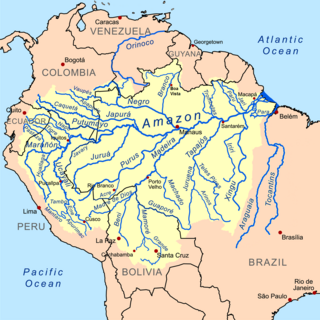
The Amazon basin is the part of South America drained by the Amazon River and its tributaries. The Amazon drainage basin covers an area of about 7,000,000 km2 (2,700,000 sq mi), or about 35.5 percent of the South American continent. It is located in the countries of Bolivia, Brazil, Colombia, Ecuador, Guyana, Peru, Suriname, and Venezuela, as well as the territory of French Guiana.
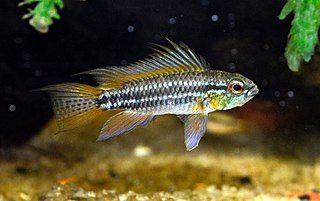
Apistogramma is a large genus of freshwater fish in the family Cichlidae native to South America, but also commonly kept in aquariums. They are dwarf cichlids that mostly feed on tiny animals and have breeding behaviors that vary depending on the exact species.

Geophagus is a genus of cichlids that mainly live in South America as far south as Argentina and Uruguay, but a single species, G. crassilabris is from Panama. They are found in a wide range of freshwater habitats. They are part of a group popularly known as eartheaters and mostly feed by picking up mouthfuls of sediment to sift out food items such as invertebrates, plant material and detritus. The largest species reach up to 28 cm (11 in) in standard length. They are mostly kept in aquariums.

Mikrogeophagus is a genus of cichlids native to the Llanos wetlands and Guaporé–Mamoré river system in tropical South America. They are dwarf cichlids that reach up to 6 cm (2.4 in) in standard length.

Acaronia is a small genus of cichlids found in the Amazon, Orinoco and other basins in northern South America.

Hypselecara is a small genus of cichlids native to the Amazon and Orinoco basins in South America. H. temporalis is a relatively common aquarium fish known in the aquarium trade as the chocolate cichild.

Biotoecus is a fish genus of cichlids from northern South America where one species (B. dicentrarchus) is found in the Orinoco Basin and the other (B. opercularis) occurs in the northern part of the Amazon Basin. These small cichlids do not surpass 10 cm (3.9 in) in length.

Biotodoma is a small genus of cichlids native to rivers in the Amazon, Orinoco and Essequibo basins in South America.
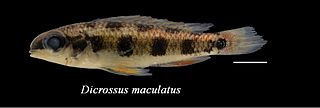
Dicrossus is a genus of small cichlid fishes native to rivers in the Amazon and Orinoco basins in South America. These cichlids have several dark spots on the sides of their bodies. Depending on the species, they typically only reach 4–7 cm (1.6–2.8 in) in length.

The threadfin acara, also known as Heckel's thread-finned acara, is a South American species of cichlid fish. It is the only member of the genus Acarichthys and is native to rivers in the Amazon and Essequibo basins in tropical South America, and has become established in southeastern Asia. It is sometimes found in the aquarium trade.

Crenicara is a small genus of cichlid fishes native to creeks and rivers in the Amazon and Essequibo basins in South America. These cichlids have several dark spots on the sides of their bodies, and do not surpass 10 cm (3.9 in) in length.
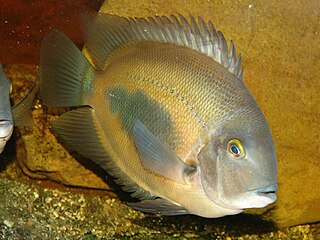
Uaru amphiacanthoides, the uaru or triangle cichlid, is a species of cichlid native to South America where it occurs in clear streams of the Amazon Basin. This species can reach a length of 25 centimetres (9.8 in) SL. It is also of importance as a food fish for native peoples and can be found in the aquarium trade.

Mesonauta, the flag cichlids, is a small genus of cichlids native to the Amazon, Orinoco, Essequibo, Paraná and Paraguay basins in South America. Mesonauta is included in the subfamily Cichlasomatinae. They occur in various freshwater habitats such as streams and lakes, especially in areas with little water movement and aquatic vegetation. They are generally found in small groups that stay near the water surface. To avoid predators, adults may jump out of the water and juveniles mimic leaves.

Sven Oscar Kullander is a Swedish biologist specialised in ichthyology. He primarily researches cichlids – notably the genus Apistogramma and the Cichlasoma-complex – and other tropical fresh water fishes. He also has been working with endangered fish species in Sweden.

Heroini is a fish tribe from the Cichlasomatinae subfamily in the cichlid family. All cichlids native to the Greater Antilles, United States, Mexico and northern Central America are members of this tribe. It also includes most cichlid species in southern Central America and several species from South America. A large percentage of its species were formerly placed in the genus Cichlasoma but have since been moved to other genera.

Krobia is a genus of cichlid fish native to freshwater habitats in South America, with three species found in the Guianas and a single in the Xingu River basin. They are typically found in small streams or creeks with little current and they feed on small invertebrates. They reach up to 12.8 cm (5.0 in) in standard length. They were formerly included in Aequidens.




















